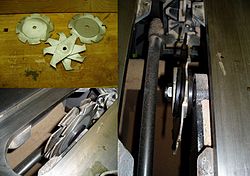- Dado set
-
A dado set or dado blade is a type of circular saw blade, usually used with a table saw or radial arm saw, which is used to cut dadoes or grooves in woodworking.
There are two common kinds of dado sets.
The first kind, known as a stacked dado set consists of two circular saw blades fixed on either side of a set of removable chippers. As the dado set spins, the two outside blades cut the dado walls and the chippers remove the waste material between and smooth the bottom of the dado. The chippers are added or removed to the set as required to make a dado of the desired width. Chippers can also be interspersed with spacers to finely adjust the dado width. Consequently, changing the dado width requires the complete removal of the dado blade set from the arbor, disassembly, addition or removal of chippers and/or spacers to achieve the desired width, reassembly and reinstallation onto the arbor.
The other kind is known as a wobble blade or wobble dado consisting of a circular blade mounted on an adjustable, multi-piece hub that varies the angle of the blade to the arbor shaft. The width of the dado cut increases as the angle gets farther from being perpendicular to the arbor. While it is possible to adjust the thickness of the cut while the saw is mounted on the arbor, accurate adjustment is usually difficult because tightening the arbor nut often changes the adjustment. Also, wobble blades, because of their inherent geometry, cannot produce a flat-bottomed dado, which may be a disadvantage in certain joinery operations. Another disadvantage of a wobble dado to that of a stacked dado is its introduction of undesirable vibrations whose magnitudes vary with the blade's angular off-set (i.e., the wider the dado, the stronger the vibrations).

This article about joinery, woodworking joints, carpentry or woodworking is a stub. You can help Wikipedia by expanding it. This tool article is a stub. You can help Wikipedia by expanding it.

